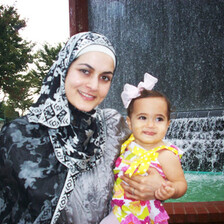Al Jazeera 27 December 2003
As home to the earliest known human settlements and the world’s holiest cities, historical Palestine is literally a treasure chest of antiquities.
Remnants of Canaanite temples and towns, Byzantine mosaics and monasteries and Mamluk and Ottoman mosques all stand witness to the region’s long and colourful past.
Many of the most important archaeological and historical sites are located in the occupied West Bank and Gaza Strip. But years of conflict have left Palestinian antiquities in a sad state and in many cases out of Palestinian control.
In Gaza, where the first recorded human settlements date back to over 6000 years ago, the old city - with its many ancient mosques, churches and other buildings - is decaying under new construction.
In an effort to combat this problem, the Centre for Heritage Architecture is working on renovating and rehabilitating several archaeological sites and historical buildings in the old quarter, including the famous Imari Mosque and the Samara Turkish baths.
But a lack of funding and technical expertise, combined with years of occupation and neglect is making the renovation process exceedingly difficult.
“Given the political situation we face, renovating and preserving archaeological and historical sites is not considered a priority by most people,” said Muhammad Ziarah, the Centre’s director.
“But somebody has to take up the responsibility, because if we lose them we’ll never get them back; these are issues of identity that are important not only for our past, but for the future,” he said.
Ancient trade route
Though often overlooked by tourists and not considered as glamorous as its West Bank and Jerusalem neighbours, Gaza is a city of great interest to archaeologists. Its historical significance stems from its unique status as an ancient trade route connecting Egypt to the Levant and crossroads between continents.
The city has seen many civilisations flourish and decline and battles waged on its grounds.
Wadi Gaza, with its wetlands, fertile soil, and potable water, for example, is thought to be home to an ancient Canaanite city in the early Bronze Period dating back to 3200 BC.
The site, known as Tal al-Sakan, was discovered in 1999 when three buildings were being erected in the area. The buildings were destroyed by Israeli occupation troops early last month.
According to the Moain Sadaq, Gaza’s leading archaeology authority and Director General of the Department of Antiquities of Gaza, Tal al-Sakan is the largest walled in Canaanite city to be discovered in Palestine so far.
But a joint French-Palestinian excavation of the site was shut down by Israeli authorities last year, citing “security concerns” and its close proximity to the Jewish settlement of Netzarim.
“The major hurdle we face is that most of the ancient sites happen to be located in the central Gaza Strip, which is considered a ‘security area’ since a large number of Jewish settlements have been established there,” said Sadaq.
Meanwhile, the ancient site has continued to deteriorate under the rumbling of Israel tanks and bulldozers. According to Sadaq, several layers of the ancient city have come loose because of nearby Israeli invasions, ranging from shelling to house demolitions.
Political archaeology
Tal al-Sakan is just one of the many examples of Palestinian archaeological sites that are in danger.
Since the start of the Intifada in 2000, most Palestinian excavations have been put on hold or have ceased.
Previously excavated and protected sites have deteriorated to an unprecedented level, according to Adal Yahya, Palestinian archaeologist and director of the Palestinian Association for Cultural Exchange.
And Israel’s apartheid wall, which is literally tearing the West Bank apart, has had a devastating effect on Palestinian archaeological sites.
Ancient ruins in cities like Tulkaram have been destroyed, damaged, or annexed altogether by Israel as the concrete barrier made its way through the area.
An ancient Christian archaeological site discovered in the Palestinian town of Abu Dis earlier this year was also damaged during construction of the wall, according to the Israeli Antiquities Authority.
Such incidents have prompted the World Archaeological Congress to adopt a strongly worded resolution condemning the Israeli practice of destroying Palestinian archaeological sites.
Historical destruction
The devastating impact of the Israeli occupation on Palestinian antiquities predates Intifada.
“Since 1967 the Israelis have completely monopolised all aspects of cultural heritage preservation in West Bank and Gaza Strip under the pretext that this is also Jewish heritage and they must be entrusted to take care of it,” said Yahya.
The science of archaeology is extremely political, he said.
Nowhere have antiquities and archaeological finds taken on more significance and symbolism than they have here in the Holy Land.
“Archaeology in the Middle East, and in the Holy Land in particular, was not only used to justify ones claims, but to falsify and deny the other sides claims and narratives.
The Palestinian-Israeli conflict is not fought by machineguns and fighter jets alone, but also by shovels, in pits, and in school curriculum and on computer screens,” said Yahya.
“Palestinians have been denied the right to preserve their own cultural heritage even if it’s in the centre of Palestinian areas. This went on even after Oslo and the handover of Palestinian towns. They have in fact alienated Palestinians from heritage.”
Some of the most important archaeological sites in the West Bank and Gaza remain under Israeli control.
In the West Bank, sites such as Joseph’s Tomb, Herodion, Sebastia, Tal al-Nasba, Gebion, Bait Al, remain under Israeli control despite handover of the Palestinian cities where they are located.
In the Gaza Strip, Roman pillars that were once part of archaeological sites in Bait Hanun, Byzantine mosaics discovered in various parts of the city, and Anthropoid coffins excavated prior to 1994 have all been seized by the Israelis.
“We are still demanding that Israel return artefacts, many of which were transported to Israeli museums during the occupation, back to us,” said Sadaq.
Ancient artefacts
As they attempt to reclaim their past and deal with the effects of the Israeli occupation of their archaeological sites, Palestinian archaeologists are faced with a host of other problems. The loss of ancient artefacts to smugglers tops their list.
According to Yahya, Israel has encouraged the illegal excavations of Palestinian archaeological sites by providing the smugglers with a venue through which to sell their illegally obtained artefacts.
A loophole in the Israeli Antiquities Law essentially allows the legal export of antiquities obtained through unlicensed or illegal excavation, further exacerbating the problem of the illicit antiquities trade.
The Israeli Antiquities Authority could not be reached for comment.
“This is the kind of business that flourishes in desperate situations like this…they resort to these very destructive acts which are ruining not only our past but our future as well,” he said.
Ownership problems
Another hurdle facing Palestinian archaeologists, especially in Gaza, is the discovery or the location of important archaeological sites on private lands.
None of the relevant archaeological authorities has enough money to offer the residents, and due to a lack of public awareness, they seldom volunteer the space for excavation on their own.
“We must be able to provide them with some sort of substitute, whether it’s another piece of land or financial compensation - but there’s not enough land in Gaza to go around and we lack funds to compensate people,” said Sadaq.
The result is that residents of historical houses often end up selling their property to new owners who are not interested in historical preservation, or demolish the home altogether in order to build a new one.
“I don’t necessarily blame people for leaving, there might be a family living in an old house, now they are 10 families, and want to move - but we have to find solutions for them,” said Ziarah.
Sadaq sees public awareness as the first step to protecting Palestinian heritage, whether through the school system or by passing an effective law in the legislative council.
“I’m afraid that one day we will wake up to [find] that the cradle of civilisation does not have any civilisation whatsoever,” said Yahya.
© Aljazeera 2003





